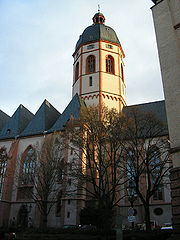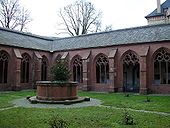
St. Stephen's Church, Mainz
Encyclopedia

Gothic architecture
Gothic architecture is a style of architecture that flourished during the high and late medieval period. It evolved from Romanesque architecture and was succeeded by Renaissance architecture....
hall collegiate church
Collegiate church
In Christianity, a collegiate church is a church where the daily office of worship is maintained by a college of canons; a non-monastic, or "secular" community of clergy, organised as a self-governing corporate body, which may be presided over by a dean or provost...
located in the German
Germany
Germany , officially the Federal Republic of Germany , is a federal parliamentary republic in Europe. The country consists of 16 states while the capital and largest city is Berlin. Germany covers an area of 357,021 km2 and has a largely temperate seasonal climate...
city of Mainz
Mainz
Mainz under the Holy Roman Empire, and previously was a Roman fort city which commanded the west bank of the Rhine and formed part of the northernmost frontier of the Roman Empire...
.
History
St. Stephan zu Mainz was originally built in 990 at the order of ArchbishopArchbishop
An archbishop is a bishop of higher rank, but not of higher sacramental order above that of the three orders of deacon, priest , and bishop...
Willigis
Willigis
Saint Willigis was Archbishop of Mainz from 975 until his death as well as a statesman of the Holy Roman Empire.-Life:...
, who also initiated the building of Mainz Cathedral
Mainz Cathedral
Mainz Cathedral or St. Martin's Cathedral is located near the historical center and pedestrianized market square of the city of Mainz, Germany...
. The church was founded on top of the highest hill in the town, most likely on behalf of Theophanu
Theophanu
Theophanu , also spelled Theophania, Theophana or Theophano, was born in Constantinople, and was the wife of Otto II, Holy Roman Emperor.-Family:...
, the widow of Otto II, Holy Roman Emperor
Otto II, Holy Roman Emperor
Otto II , called the Red, was the third ruler of the Saxon or Ottonian dynasty, the son of Otto the Great and Adelaide of Italy.-Early years and co-ruler with Otto I:...
. Willigis intended the church to be a site of prayer for the Empire.
The provost
Provost (religion)
A provost is a senior official in a number of Christian churches.-Historical Development:The word praepositus was originally applied to any ecclesiastical ruler or dignitary...
of the Collegiate Church administered one of the archdiaconate
Deacon
Deacon is a ministry in the Christian Church that is generally associated with service of some kind, but which varies among theological and denominational traditions...
s (a medieval organizational form similar to today's diaconates) of the Archbishopric of Mainz
Archbishopric of Mainz
The Archbishopric of Mainz or Electorate of Mainz was an influential ecclesiastic and secular prince-bishopric in the Holy Roman Empire between 780–82 and 1802. In the Roman Catholic Church hierarchy, the Archbishop of Mainz was the primas Germaniae, the substitute of the Pope north of the Alps...
.
The building
The current church building dates from the late medieval era; construction of the main area of the church began in about 1267 and was completed in 1340. The successional building kept the guidelines of the floor plan of the original Willigis building and with it the design as a double quireQuire (architecture)
Architecturally, the choir is the area of a church or cathedral, usually in the western part of the chancel between the nave and the sanctuary . The choir is occasionally located in the eastern part of the nave...
church. St. Stephan is the oldest Gothic
Gothic architecture
Gothic architecture is a style of architecture that flourished during the high and late medieval period. It evolved from Romanesque architecture and was succeeded by Renaissance architecture....
hall church
Hall church
A hall church is a church with nave and side aisles of approximately equal height, often united under a single immense roof. The term was first coined in the mid-19th century by the pioneering German art historian Wilhelm Lübke....
in the Upper Rhine
Upper Rhine
The Upper Rhine is the section of the Rhine in the Upper Rhine Plain between Basel, Switzerland and Bingen, Germany. The river is marked by Rhine-kilometers 170 to 529 ....
district, and is (besides Mainz Cathedral) the most important church in the city of Mainz.

Baroque
The Baroque is a period and the style that used exaggerated motion and clear, easily interpreted detail to produce drama, tension, exuberance, and grandeur in sculpture, painting, literature, dance, and music...
period. In 1857 a great explosion in a nearby powder magazine (Mainz was a federal fortress in the 19th century) destroyed the baroque facing of the church.
St. Stephan was heavily damaged during World War II
World War II
World War II, or the Second World War , was a global conflict lasting from 1939 to 1945, involving most of the world's nations—including all of the great powers—eventually forming two opposing military alliances: the Allies and the Axis...
. The cloister was heavily damaged and was rebuilt between 1968 and 1971; the restoration of the huge western belfry was also completed at that time, albeit with some difficulty. The arches over the nave and the quire could not be saved and have been replaced by a flat wooden ceiling.
The church features a Gothic hall with a triple nave and quires at both the west and east ends. A large octagonal bell tower rises above the western quire.
Decorations and furnishings

Chagall windows
The Chagall choir windows in St. Stephan are unique in Germany. Between 1978 and his death in 1985, RussiaRussia
Russia or , officially known as both Russia and the Russian Federation , is a country in northern Eurasia. It is a federal semi-presidential republic, comprising 83 federal subjects...
n Jewish artist Marc Chagall
Marc Chagall
Marc Chagall Art critic Robert Hughes referred to Chagall as "the quintessential Jewish artist of the twentieth century."According to art historian Michael J...
created nine stained-glass windows of scriptural figures in luminous blue. The figures depict scenes from the Old Testament, demonstrating the commonalities across Christian and Jewish traditions. Chagall intended his work to be a contribution to Jewish-German reconciliation, made all the more poignant by the fact that Chagall himself fled France under Nazi occupation. He chose St. Stephan due to his friendship with Monsignor Klaus Mayer, who was then the presiding priest of St. Stephan. Chagall's work has been continued since his death by his pupil Charles Marq and by others.
Others
Despite the immense damage caused by both WWII and the powder explosion to St. Stephan, the 13th century altar mensa (or table) and the huge TabernacleChurch tabernacle
A tabernacle is the fixed, locked box in which, in some Christian churches, the Eucharist is "reserved" . A less obvious container, set into the wall, is called an aumbry....
dating from about 1500 have both survived.
Archbishop Willigis
Willigis
Saint Willigis was Archbishop of Mainz from 975 until his death as well as a statesman of the Holy Roman Empire.-Life:...
was buried in the church in 1011. His resting place is no longer known, but it is believed he is buried in the collegiate area.
Literature
- Klaus Mayer: St. Stephan in Mainz. Kleine Kunstführer Nr. 523. 15., erweiterte Auflage. Schnell & Steiner, Regensburg 2009, 59 S., ISBN 978-3-7954-4311-5; English: 6. Aufl. 2007, ISBN 978-3-7954-4310-8; French: 3. Aufl. 2002, ISBN 978-3-7954-6042-6
External links
- St. Stephan on the city website
- Additional Information from the Diocese of Mainz

